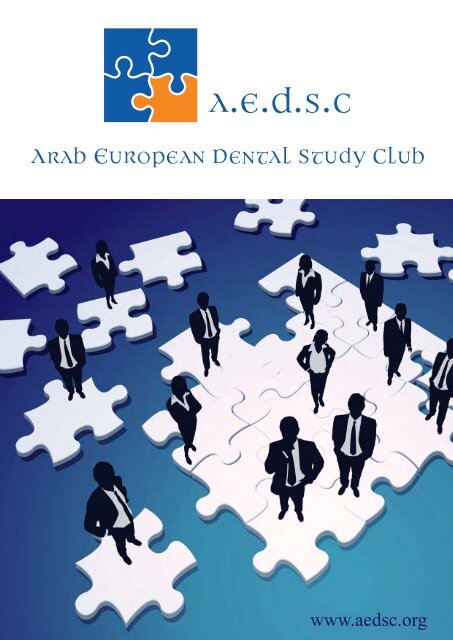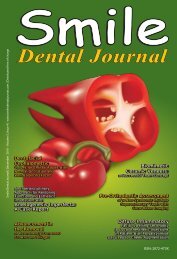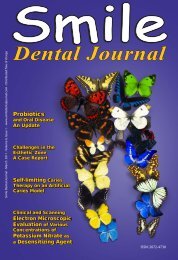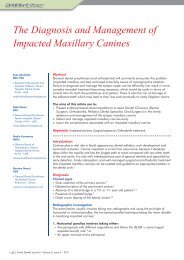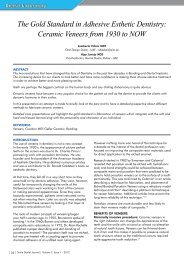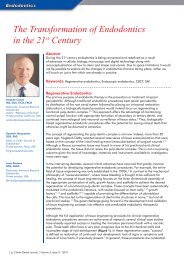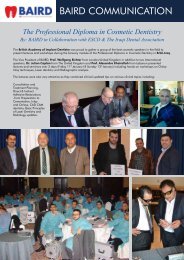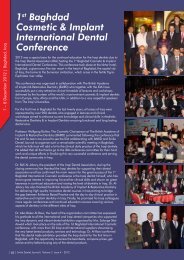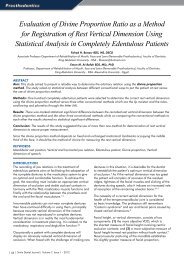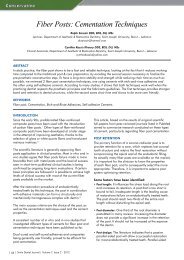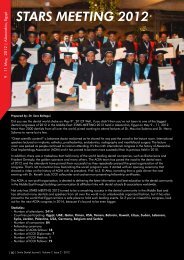Download e-copy - Smile Dental Journal
Download e-copy - Smile Dental Journal
Download e-copy - Smile Dental Journal
You also want an ePaper? Increase the reach of your titles
YUMPU automatically turns print PDFs into web optimized ePapers that Google loves.
Patient O. from case 1 has undergone CT scan examinations<br />
several months after the completion of the treatment. The<br />
goal of this research was to evaluate the long term effect of<br />
the completed interdisciplinary treatment on the condition<br />
and integrity of the alveolar bone and on the position and<br />
stability of the roots of the teeth within the bone. An image<br />
from this examination can be seen in fig. 19.<br />
The assessments of this and other images for this patient<br />
are consistent with the picture of normal alveolar bone<br />
with roots of the teeth positioned proportionally within<br />
the boundaries of the bone. There is no visible damage,<br />
dehiscences or fenestrations in the buccal alveolar plate and<br />
no bone loss can be observed.<br />
These CT scans illustrate the “whole bone” remodeling<br />
response to successfully performed orthopedic and<br />
orthodontic treatment.<br />
Conclusion<br />
The addition of the orthodontic treatment to interdisciplinary<br />
approach to solve TMD can result in permanent resolution of<br />
the patient’s TMJ issues. The final outcome of this treatment<br />
results in much improved position inside TM joints, significant<br />
enhancement of the patient’s overall facial appearance,<br />
occlusion, function and esthetic aspects of the smile. This<br />
treatment philosophy gives the dentist an opportunity to<br />
assess patients in a different way. The ensuing orthodontic<br />
treatment with special attention paid to dentofacial<br />
orthopedics allows for the remodeling of a patient’s alveolar<br />
bone and whole dentoalveolar complex. The bone movement<br />
creates a proper orthopedic relationship between the jaws<br />
with stable results and healthier TMJ. The implementation<br />
of this phase of the treatment places teeth and jaws in the<br />
position that dramatically improves the dentist’s ability<br />
to perform its restorative part. The overall results of the<br />
treatment are elimination of the majority of TMJ problems,<br />
much improved facial appearance, youthful look and proper<br />
occlusion allowing for better patient’s functional ability and<br />
esthetically attractive smile.<br />
References<br />
1. LeResche L. Epidemiology of temporomandibular disorders: implications for the<br />
investigation of etiologic factors. Crit Rev Oral Biol Med. 1997;8:291-305.<br />
2. Luter F. TMD and occlusion part I. Damned if we do? Occlusion: the interface<br />
of dentistry and orthodontics. British <strong>Dental</strong> <strong>Journal</strong>. 2007;202:E2.<br />
3. Luter F, Layton S, McDonald F. Orthodontics for treating temporomandibular<br />
joint(TMJ) disorders (Review). 2010 The Cochrane Collaboration.<br />
4. Wyatt W.E. Preventing adverse effects on the temporomandibular joint through<br />
orthodontic treatment. Am J Orthod Dentofacial Orthop. 1987;91:493-9.<br />
5. Capurso U, Marni I. Orthodontic treatment of TMJ disc displacement with<br />
pain: an 18 year follow-up. Prog Orthod. 2007;8(2):240-50.<br />
6. Dennis R. Brenkert. Orthodontic treatment for the TMJ patient following splint<br />
therapy to stabilize a displaced disk(s): a systemized approach. Part I, TMJ<br />
orthodontic diagnosis. Cranio: The <strong>Journal</strong> of Craniomandibular Practice.<br />
28.3 (July 2010) p.193.<br />
7. Dennis R. Brenkert. Orthodontic treatment for the TMJ patient following<br />
splint therapy to stabilize a displaced disk(s): a systemized approach. Part II.<br />
Cranio: The <strong>Journal</strong> of Craniomandibular Practice. 28.4 (Oct. 2010) p.260.<br />
8. Desteno C V, et al.: Phase II rehabilitation of the temporomandibular joint<br />
dysfunction patient. Clin Prey Dent. 1989; 11(5):29-32.<br />
9. Birte Melsen. Biological reaction of alveolar bone to orthodontic tooth<br />
movement. The Angle orthodontist. 1999;69(2):151-6.<br />
10. Birte Melsen. Tissue reaction to orthodontic tooth movement - a new<br />
paradigm. European <strong>Journal</strong> of Orthodontics. 2001;23:671-81.<br />
11. Cacciafesta V. Dr. Birte Melsen on adult orthodontic treatment. J Clin<br />
Orthod. 2006;12:703-16.<br />
12. Michael O. Williams and Neal C. Murphy. Beyond the Ligament: A Whole-<br />
Bone Periodontal View of Dentofacial Orthopedics and Falsification of<br />
Universal Alveolar Immutability. Seminars in Orthodontics, Vol. 14, No 4<br />
(December), 2008;246-59.<br />
| 30 | <strong>Smile</strong> <strong>Dental</strong> <strong>Journal</strong> | Volume 6, Issue 4 - 2011


